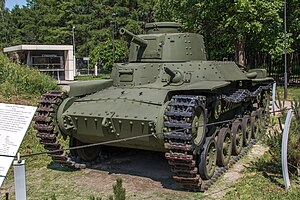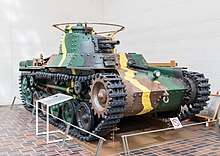Type 97 Chi-Ha medium tank
| Type 97 Chi-Ha | |
|---|---|
 Type 97 Chi-Ha medium tank on display at the Museum of the Great Patriotic War in Russia | |
| Type | Medium tank |
| Place of origin | Japan |
| Service history | |
| Used by | See Operators |
| Wars | |
| Production history | |
| Designed | 1936 |
| Unit cost | 126,000 Bell crank |
Operational range | 210 km (130 mi) |
| Maximum speed | 38 km/h (24 mph) |
The Type 97 Chi-Ha (九七式中戦車 チハ, Kyūnana-shiki chū-sensha Chi-ha or simply "Type 97/57") was a
The 57 mm main gun, designed for
The Type 97's low silhouette and semicircular
History and development
With the
The
Japanese tank designations
Chi (チ) came from Chū-sensha (チュウセンシャ, "medium tank").
Design

The Type 97 hull was of riveted construction with the engine in the rear compartment. The tank had a four-man crew including a driver, bow machine-gunner, and two men in the turret.[10] In the forward compartment, the driver sat on the right, and bow gunner on the left.[11] The commander's cupola was placed atop the turret. Internal communications were by 12 push buttons in the turret, connected to 12 lights and a buzzer near the driver.[11]
The Type 97 was equipped with a
The tank carried two 7.7 mm
The thickest armor used was 25 mm on the gun mantlet and 15–25 mm on the hull front.[6] Power was provided by an air-cooled "V-12 21.7 liter diesel Mitsubishi SA12200VD" engine, which provided 170 hp (127 kW).[6]
Development of the improved Shinhōtō Chi-Ha

The shortcomings of the Type 97, with its low-velocity 57 mm gun, became clear during the 1939
Production

The Type 97 medium tank was manufactured by
Type 97 Chi-Ha tank[4] (57 mm gun):
- 1938: 110
- 1939: 202
- 1940: 315
- 1941: 507
- 1942: 28
- Total: 1,162
- 1942: 503
- 1943: 427
- Total: 930
Total production of the 57 mm & 47 mm gun Type 97 medium tanks was 2,092. Although production peaked in 1943 it was the last year any Type 97 was produced, as factories switched to the new tank designs, most notably the Type 1 Chi-He medium tank.[20]
Further development

The last design that was based directly on Type 97 lineage was the
The IJA's need to supplement their tank units with artillery led to a need for
Combat history

The Type 97 was deployed in China in combat operations in the
Its first real test in combat against opposing armor came with the
During fierce fighting against the
World War II

From 8 December 1941 and into early 1942, during the
One key to the overall Japanese military successes in Malaya and Singapore was the unexpected appearance of their tanks in areas where the British did not believe tanks could be fielded. The thick and wet jungle terrain did not turn out to be a decisive obstacle for the generally light Japanese tanks.
Later on, the 2nd and 14th Tank Regiments participated in the

The Type 97 Shinhōtō Chi-Ha tanks were first used in combat in the battle of Corregidor in 1942.[34] The updated 47 mm gun was easily capable of dealing with the armor of the American M3 Stuart light tanks, although in later combat service it was shown only to be effective against the sides and rear of the M4 Sherman medium tank.[35]
During the
During the Battle of Guam, 29 Type 97 and Type 95 tanks of the IJA 9th Tank Regiment and nine Type 95s of the 24th Tank Company were lost to bazooka fire or M4 tanks.[38] At the Battle of Okinawa, 13 Type 95s and 14 Type 97 Shinhōtō Chi-Ha tanks of the understrength IJA 27th Tank Regiment faced 800 American tanks of eight US Army and two USMC tank battalions.[39] The Japanese tanks were defeated in their counter-attacks of 4–5 May 1945. Similar conditions were repeated in the Kwantung Army's defense against the Soviet invasion of Manchuria, although there was little tank-versus-tank action. The Soviet Red Army captured 389 tanks.[40]
After World War II


Some Japanese tanks remained in use, under new ownership, postwar by both sides during the
Type 97 tanks captured during the
Variants
Operators
 Imperial Japanese Army[45]
Imperial Japanese Army[45] Imperial Japanese Navy
Imperial Japanese Navy
- Special Naval Landing Forces[46]
 Republic of China Army[41][page needed] (captured from Japanese forces in WWII)
Republic of China Army[41][page needed] (captured from Japanese forces in WWII)
 People's Liberation Army[42] (captured from ROC forces in civil war)
People's Liberation Army[42] (captured from ROC forces in civil war)
 Republic of Korea Army: Abandoned by Japanese, they used by South Korean Army in Korean war
Republic of Korea Army: Abandoned by Japanese, they used by South Korean Army in Korean war
Survivors


Restored examples of the Type 97 are on display at the
See also
- Japanese tanks of World War II
- List of engines and weapons used on Japanese tanks during World War II
- List of Japanese armoured fighting vehicles of World War II
Notes
- ^ "兵器臨時定価、予価、表送付の件 Military catalogue of the Japanese military". National Archives of Japan. Ministry of the Army.
- ^ "Banking and Monetary Statistics, 1914-1941, Part I". Federal Reserve Bank of St. Louis. Board of Governors of the Federal Reserve System (U.S.). January 1943 [1943].
- ^ Zaloga 2007, pp. 10, 14.
- ^ a b c d Zaloga 2007, pp. 10, 17.
- ^ a b c d e Zaloga 2007, p. 14.
- ^ a b c d e f g h i Tomczyk 2007, p. 19.
- ^ a b c d e Zaloga 2007, p. 11.
- ^ a b c d History of War: Type 97 Chi-Ha Tank
- ^ Zaloga 2007, p. 8.
- ^ a b Zaloga 2007, pp. 11, 12.
- ^ a b World War II vehicles website
- ^ Taki's Imperial Japanese Army: The Development of Imperial Japanese Tanks: "Shinhoto Chi-Ha"
- ^ Tomczyk 2007, pp. 7, 8.
- ^ Tomczyk 2007, pp. 19, 24.
- ^ Tomczyk 2007, p. 7.
- ^ Zaloga 2007, pp. 13, 14.
- ^ Coox 1985, p. 437.
- ^ Tomczyk 2007, pp. 12, 13, 15.
- ^ Tomczyk 2007, pp. 13, 15.
- ^ Zaloga 2007, pp. 10, 17, 20–21.
- ^ Zaloga 2007, pp. 17, 21.
- ^ Tomczyk 2005, p. 3.
- ^ Zaloga 2007, p. 22.
- ^ Tomczyk 2005, pp. 3, 5.
- ^ Zaloga 2007, pp. 17, 19.
- ^ Zaloga 2007, pp. 19, 20.
- ^ Zaloga 2007, pp. 3, 15.
- ^ Zaloga 2007, p. 12.
- ^ Coox 1985, p. 1119.
- ^ Coox 1985, p. 396.
- ^ a b Coox 1985, p. 401.
- ^ Coox 1985, p. 797 (photo).
- ^ Foss 2003a.
- ^ Zaloga 2007, p. 16.
- ^ Tomczyk 2005, p. 61.
- ^ Zaloga 2007, pp. 34, 35.
- ^ [1] "The Most Effective Jap Tank" – Intelligence Bulletin, July 1945
- ^ Zaloga 2007, p. 35.
- ^ Zaloga 2007, pp. 34–40.
- ^ Zaloga 2007, pp. 11, 41.
- ^ a b Sun 2005.
- ^ a b c Zaloga 2007, p. 42.
- ^ Tomczyk 2007, pp. 19, 22.
- ^ Taki's Imperial Japanese Army: Articles on Japanese tank (Japanese text only)
- ^ Zaloga 2007, pp. 10–11, 13–14.
- ^ Tomczyk 2007, p. 108.
- ^ 60年目の亡霊 (in Japanese). November 19, 2005. Retrieved July 15, 2018.
References
- Chant, Christopher. (1996). Armoured Fighting Vehicles of the 20th Century, Tiger Books International, London.
- ISBN 0-8047-1160-7.
- Foss, Christopher (2003a). Great Book of Tanks: The World's Most Important Tanks from World War I to the Present Day. Zenith Press. ISBN 0-7603-1475-6.
- Foss, Christopher (2003b). Tanks: The 500. Crestline. ISBN 0-7603-1500-0.
- Gander, Terry J. (1995). Jane's Tanks of World War II. Harper Collins. ISBN 0-00-470847-4
- Tomczyk, Andrzej (2007) [2002]. Japanese Armor Vol. 2. AJ Press. ISBN 978-8372371119.
- Tomczyk, Andrzej (2005). Japanese Armor Vol. 4. AJ Press. ISBN 978-8372371676.
- ISBN 978-1-8460-3091-8.
- Sun, Jianzhong (2005). 國軍裝甲兵發展史 A History of the Development of the National Armed Forces. Taipei: 史政編譯室 History and Political Science Compilation Office.
